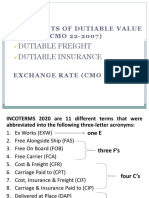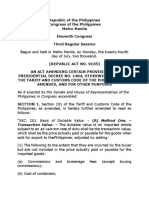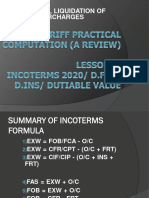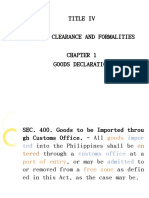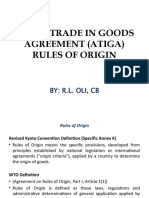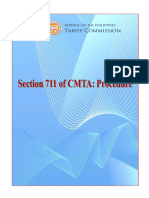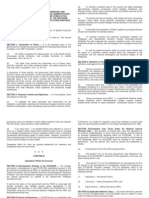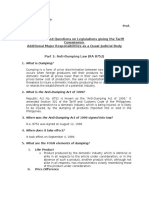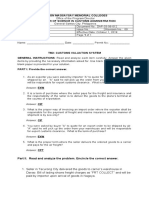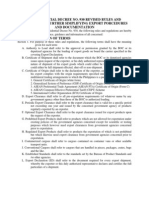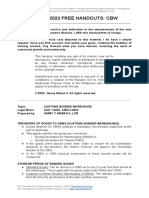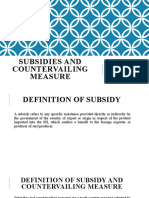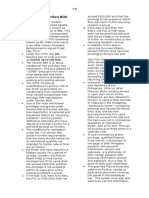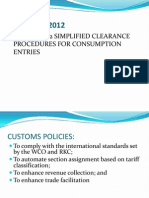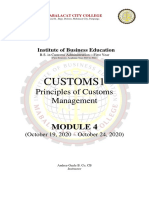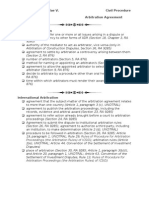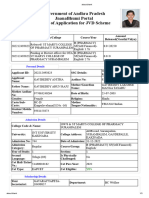NOU CBLE 2023 - 1st CL Mock Board Exam Answer Key 1
NOU CBLE 2023 - 1st CL Mock Board Exam Answer Key 1
Uploaded by
Easter Jane BostonCopyright:
Available Formats
NOU CBLE 2023 - 1st CL Mock Board Exam Answer Key 1
NOU CBLE 2023 - 1st CL Mock Board Exam Answer Key 1
Uploaded by
Easter Jane BostonOriginal Title
Copyright
Available Formats
Share this document
Did you find this document useful?
Is this content inappropriate?
Copyright:
Available Formats
NOU CBLE 2023 - 1st CL Mock Board Exam Answer Key 1
NOU CBLE 2023 - 1st CL Mock Board Exam Answer Key 1
Uploaded by
Easter Jane BostonCopyright:
Available Formats
NOTICE TO THE PUBLIC:
ALL MATERIALS PROVIDED ARE PROTECTED UNDER PHILIPPINE COPYRIGHT LAW.
UNAUTHORIZED REPRODUCTION OR DISTRIBUTION OF THIS
MATERIAL IS S TRICTLY PROHIBITED.
CBLE MOCK BOARD EXAM (MBE) SCHEDULE
SUBJECT MBE SCHEDULE REGISTRATION
1st CDP MBE SUN, Sept 24, 2023 (8AM-11AM) CLOSED
2nd CDP MBE SAT, Oct 7, 2023 (8AM-11AM) From Sep 24 to Oct 5 (Registration
Link: 2nd & 3rd CDP MBE)
3rd CDP MBE SAT, Oct 7, 2023 (1PM-4PM)
1st CL MBE SUN, Oct 1, 2023 (8AM-11AM) CLOSED
2nd CL MBE SAT, Oct 14, 2023 (8AM-11AM) Oct 1 - Oct 12 (Registration Link: 2nd &
3rd CL MBE)
3rd CL MBE SAT, Oct 14, 2023 (1PM-4PM)
These exams consist of unique sets of questions and each differs from the others.
There are no recycled questions.
Exam Tip:
1. Sometimes, multiple answers may appear correct. Always select the one that
answers the question most accurately.
2. If a question seems too straightforward, review it carefully to ensure you didn’t miss
any details.
3. Begin by reading the question thoroughly, and then consider the provided facts to
accurately navigate through the potential answers.
4. Avoid rushing. Ensure that you spend adequate time understanding and answering
each question to the best of your ability.
CBLE 2023: 1st CL MOCK BOARD EXAM ANSWER KEY
Prepared by: Jimmy T. Maban II, LCB
1. A registered importer was found to have discrepancies between the application
and the CPRS. How many calendar days does the importer have to respond to the
issue before the application can be potentially disapproved?
a. 3 days
b. 5 days
c. 7 days
d. 10 days
2. A Philippine company imports fuel which is then used for the propulsion of
vessels involved in coastwise trade. To what extent can the company avail of a
refund or tax credit on the duty imposed on the imported fuel?
a. 50% of the duty imposed
b. 99% of the duty imposed
c. 100% of the duty imposed
d. No refund or tax credit is allowed for fuel used in coastwise trade
© 2023, Jimmy Maban II. All rights reserved.
3. An importer, who wishes to have their accreditation renewed, needs to submit
which of the following?
a. A certificate proving attendance of 8 hours of training on duties and
responsibilities.
b. A current and detailed company profile with geotagged photos inclusive of
latitude, longitude, date, and time.
c. The BCOR as proof of Processing Fee payment and printed CPRS with
"STORED" status.
d. A written authorization from the District Collector for every item they intend to
import.
4. A major corporation regularly imports large quantities of goods into the
Philippines. In order to ensure compliance with the CMTA and to use its resources
effectively, the Bureau of Customs would MOST likely utilize:
a. A continuous day-to-day inspection of every single shipment from the
corporation.
b. Risk management systems and audit-based controls to periodically assess the
corporation's compliance.
c. The power of mutual administrative assistance agreements to ask other
countries to inspect shipments before they arrive in the Philippines.
d. Sole reliance on automated systems to determine the legality of the corporation's
imports without any human intervention.
5. An international corporation decided to facilitate its payment for a bulk purchase
of raw materials through a banking instrument, ensuring the supplier only gets
paid once the specific conditions of delivery are met. This method allows the
buyer to have control of the goods before releasing the payment. What financial
instrument is the corporation using in this scenario?
a. A guaranty, which ensures that the supplier will be compensated in case of any
discrepancies in the delivery.
b. A line of credit, providing the corporation with a limit to which they can make
purchases.
c. A letter of credit, allowing the supplier to get paid once the conditions set in the
credit are met.
d. An application agreement, ensuring the alignment of all parties on the conditions
of the transaction.
6. Which of the following is NOT a valid ground for the Bureau to pre-terminate VASP
accreditation?
a. A VASP's violation of the terms in the Service Level Agreement (SLA).
b. A VASP's failure to pay the monitoring and supervision fee.
c. Actions that harm the security and integrity of Bureau operations.
d. VASP's violation of the Data Privacy Act.
7. Where are goods usually sold or disposed of during a public auction?
a. At the place directed by the Commissioner.
b. At a place chosen by the District Collector.
c. At the port where they are located.
d. At the port of entry.
8. A foreign vessel, suspected of carrying smuggled goods, has just left Philippine
territorial waters. Which of the following principles allows the Bureau of Customs
(BOC) to pursue the vessel into international waters based on a violation that
occurred within Philippine jurisdiction?
a. Broad Jurisdiction
© 2023, Jimmy Maban II. All rights reserved.
b. Customs Control Scope
c. Doctrine of Hot Pursuit
d. Mutual Administrative Assistance Agreements
9. Cedric, a Customs Broker, is currently facing disciplinary action for certain
violations of customs laws. As part of the process, which office or entity is likely
to be informed or provided a list of brokers with pending or resolved revocation
cases?
a. Bureau of Internal Revenue (BIR)
b. Accredited Integrated Professional Organization (AIPO)
c. Professional Regulatory Board for Customs Brokers (PRBCB)
d. Account Management Office (AMO)
10. An entity wishes to be accredited under the AEO Program. Which of the following
factors would the Bureau NOT evaluate when assessing the risk of the applicant
for AEO Membership Accreditation?
a. Business ownership, structure, and organization.
b. List of entities they've had a financial dispute with in the last 5 years.
c. Customs compliance history.
d. Internal customs compliance control.
11. After an "expressly abandoned" declaration, the status of the ownership of the
goods:
a. Can be reclaimed by the owner after 30 days provided all legal requirements are
fulfilled.
b. Remains with the owner but is held under customs custody.
c. Is automatically transferred to the government.
d. Can be compromised upon by the Commissioner.
12. An importer is trying to determine the transaction value for a shipment of goods.
Which of the following items should NOT be added to the price actually paid or
payable for the imported goods when determining the transaction value?
a. Commissions and brokerage fees excluding buying commissions.
b. The cost of transporting the imported goods from the seller's warehouse to the
port of exportation.
c. Cost of packing, both labor, and materials associated with packing.
d. The value of certain goods and services supplied directly by the buyer at a
reduced cost.
➢ Explanation: When determining the transaction value for a shipment of
imported goods, the cost of transporting those goods from the seller's
warehouse to the port of exportation should NOT be added to the price
actually paid or payable. This is particularly true when the Incoterm
applied is F, C, or D term. The exception is the EXW Incoterm, where the
buyer pays only for the goods and the seller's obligation is to make them
available at their premises. According to CMO 16-2010, transportation
costs encompass elements like trucking, inland and ocean freight, rail, air,
barge, lighterage, and postal costs. If importers utilize their own vessel or
aircraft, they must compute the "actual cost" of transportation following
the Generally Accepted Accounting Principles (GAAP).
13. Company X, registered under the Investment Incentives Act (Republic Act No.
5186), previously enjoyed tax credits based on customs duties paid on imported
raw materials which were subsequently processed and reexported. Which of the
© 2023, Jimmy Maban II. All rights reserved.
following is correct regarding Company X's eligibility for drawbacks on the same
importation?
a. Company X is entitled to a drawback for the same importation since they
reexported the processed goods.
b. Company X is not entitled to a drawback since enterprises registered under
Republic Act No. 5186 cannot avail of such incentives.
c. Company X can avail of partial payments of drawbacks for the same importation.
d. Company X is entitled to a drawback, but only if the drawback does not exceed
50% of the duty imposed on the imported materials.
14. Ms. Abella, a sole proprietor, applied for her first-time importer accreditation with
the Bureau. Which of the following documents is NOT required from her during
the application process?
a. Cooperative Resolution.
b. Lease contract or proof of lawful occupancy.
c. A detailed personal profile of herself.
d. Written Authority as Signatory including an affidavit.
15. The commissioner of customs intends to increase enforcement actions in a new
customs-controlled zone that includes an airport, seaport, and multiple
warehouses. A customs broker wishes to advise their clients on what areas are
subject to unhampered access by customs officers. Which of the following is
accurate?
a. Customs officers have unhampered access to ports, airports, and customs-
controlled zones, but warehouses can deny entry without a specific warrant.
b. Customs officers only have access to the seaport and airport, but not the
customs-controlled zone.
c. Customs officers have unhampered access to all premises, including ports,
airports, customs-controlled zones, and warehouses, within their administrative
jurisdiction.
d. The commissioner must issue a separate decree to grant customs officers
unhampered access to the new customs-controlled zone.
16. Juan, a Customs Broker, has decided to form a General Professional Partnership
(GPP) with his close friend, Marco. If Juan and Marco want to register their GPP
with the Bureau of Customs, which of the following requirements must they meet?
a. Each partner must complete a separate application form with a non-refundable
fee of Php5,000.
b. They must submit a notarized list of representatives, undertakings, and verified
photocopies of each partner's National Bureau of Investigation (NBI) clearance.
c. Only the Managing Partner needs to submit their latest Income Tax Return (ITR)
for the past three years.
d. The partnership's Certificate of Registration is automatically cancelled upon the
resignation or retirement of any partner.
17. A customs official stops a vehicle at a customs checkpoint based on a tip that it
may be carrying prohibited items inside a coffin. Before searching the coffin, the
customs officer should:
a. Ensure that he has a written permission from the local health department to
inspect human remains.
b. Have a clear and justifiable suspicion or reasonable cause that the vehicle is
transporting dutiable or prohibited goods.
© 2023, Jimmy Maban II. All rights reserved.
c. Wait for the next of kin or family members of the deceased to be present during
the search.
d. Conduct the search only if the coffin is not sealed, as sealed coffins are exempt
from searches under customs laws.
18. An AEO member is currently benefiting from Level 1 certification. What would
they NOT benefit from at this level?
a. Exemption from renewal of accreditation (e.g., Importer accreditation).
b. Dedicated processing lane for AEO shipments without documentary or physical
inspection.
c. Dedicated help desk for AEO applicants.
d. For AEO members with satisfactory trade document management, the Bureau
may allow self-assessment of duty/tax liability and customs requirement
compliance.
19. An importer failed to pay duties and taxes upon final assessment, resulting in his
imported goods being categorized as:
a. Expressly abandoned goods.
b. Impliedly abandoned goods due to failure to mark within the prescribed period.
c. Impliedly abandoned goods due to customs enforcement intervention.
d. Impliedly abandoned goods due to failure to pay duties and taxes upon final
assessment.
20. Which of the following goods are NOT subject to condemnation?
a. Goods with commercial value.
b. Goods that are injurious to public health.
c. Absolutely prohibited goods, as specified by CMTA.
d. Highly dangerous restricted goods.
21. Company X had their AEO accreditation suspended by the Bureau. Which of the
following reasons is NOT a valid ground for suspension?
a. Habitual delinquency in complying with AEO regulations or membership terms
and conditions.
b. Failure to provide free training to the Bureau staff on their internal processes.
c. Intentional violation of the CMTA or related laws, causing significant customs
revenue loss or serious public welfare injury.
d. Recommendation based on evaluation indicating significant risk to customs
revenue or cargo supply chain security.
22. An accredited importer has just inadvertently misdeclared the quantity of
imported goods. Which of the following statements is most accurate concerning
the implications for the importer?
a. Inadvertent errors in goods declaration are exempted from penalties.
b. Misdeclaration, even if inadvertent, can lead to the issuance of a Warrant of
Seizure and Detention and a possible preliminary suspension of accreditation.
c. The importer has the right to request an examination after the lodgment without
any consequences.
d. All misdeclarations are treated with a standard penalty regardless of the nature
of the error.
23. Which of the following best describes a Tax Credit Certificate (TCC)?
a. It is a peso-for-peso reduction from a taxpayer's tax liability directly subtracted
from the tax payable to the government.
b. It is the amount due to a taxpayer resulting from an overpayment of a tax liability
or erroneous payment of a tax due.
© 2023, Jimmy Maban II. All rights reserved.
c. It is a certification issued to the taxpayer, acknowledging the taxpayer's
entitlement to a tax credit, which can be used for settling specific internal revenue
tax liabilities, converted as a cash refund, or otherwise disposed of as per
guidelines.
d. It is a formal documentation submitted by a taxpayer when requesting a refund
due to overcharged duties and taxes.
24. An exporter from a foreign country sent a gift to his friend in the Philippines
through mail. The gift is a unique handcrafted vase, not in commercial quantity.
Upon arrival, how should this gift be processed for customs clearance?
a. It must be subject to the lodgement of a goods declaration for consumption.
b. It can be cleared using an informal entry process as it is a personal effect, not in
commercial quantity.
c. The vase needs to be admitted to a free zone as defined in the CMTA.
d. The receiver must provide a letter of credit evidencing payment for the vase
before it can be cleared.
25. A local manufacturing company used imported materials to produce goods which
were then exported. If the goods were exported on January 10, 2023, what is the
last date by which the company must file a claim for a drawback for duties paid on
the imported materials used in their production?
a. January 10, 2024
b. December 31, 2023
c. January 31, 2024
d. The date of importation of the materials
26. For a VASP applying for accreditation, which of the following statements is
accurate regarding their eligibility and process of application?
a. Joint ventures are ineligible, even if they comply with the 60%-40%
Filipino-foreign ownership rule.
b. An applicant VASP can electronically submit the Letter of Intent and other
documentary requirements.
c. The VASP Accreditation Committee (VAC) will notify unqualified applicants within
seven working days after the submission deadline.
d. Once a VASP is accredited, it can immediately commence its services without
any further notice from the VAC.
27. A customs officer suspects that a warehouse in a seaport contains smuggled
goods. Upon inspection, it was found that two security guards reside inside the
warehouse for security purposes. Can the customs officer legally search the
warehouse without a warrant?
a. No, because the warehouse is considered a dwelling house since security
personnel reside within it.
b. Yes, because a warehouse used for storage of goods is not considered a
dwelling house even if employees reside within.
c. No, because any structure with human occupants is automatically classified as a
dwelling house.
d. Yes, but only the areas where the security personnel don't reside.
28. If a Value Added Service Provider (VASP) wishes to share confidential business
information, which of the following actions must be taken before the information
is disclosed?
a. Obtain consent from the VASP's client.
b. Secure permission from the Bureau's automated system.
© 2023, Jimmy Maban II. All rights reserved.
c. Get written consent from the Bureau.
d. Obtain clearance from the Philippine Competition Commission.
29. A customs processing entity is under post-clearance audit. The Bureau of
Customs wants to examine the entity's records pertaining to customs clearance
activities. For how long is the customs processing entity required to keep records
at their principal place of business from the date of filing the goods declaration?
a. One year
b. Two years
c. Three years
d. Five years
30. Lara, a representative of a registered Customs Broker, accidentally made an error
in the documentation. Who among the following can be held responsible for the
error?
a. Only the Customs Broker's representative, as she is the one who directly
committed the error.
b. Both the Customs Broker and the representative, since the broker must
supervise their representative closely.
c. The Commissioner of Customs, as they are ultimately responsible for overseeing
the entire process.
d. The consignee or importer, as the goods belong to them.
31. A private company is contracted by the Bureau to provide janitorial services and,
in another instance, to handle data processing as a Value Added Service Provider.
Which of the following conditions apply to the private company?
a. Only the provisions under the Government Procurement Reform Act need to be
followed for both services.
b. The janitorial services fall under the exemptions, while the data processing
service must comply with the Data Privacy Act of 2012.
c. Both services can be outsourced without the approval of the Secretary of
Finance.
d. The janitorial services require the company to adhere to the Official Development
Assistance Act of 1996.
32. The Bureau of Customs intends to ensure the collection of import duties and
taxes from an importer who owes nine thousand pesos. Which of the following
actions is NOT permissible for the Bureau based on the owed amount?
a. Pursuing a civil action against the importer.
b. Using the remedy of levy on the importer's property.
c. Using the remedy of distraint on the importer's personal property.
d. Advancing the amounts needed to cover the costs of collection.
33. An importer wishes to obtain an advance ruling to ascertain whether their product
qualifies for preferential tariff treatment under a specific trade agreement. Which
section should the importer refer to, and with whom should the application be
filed?
a. Refer to Section 1100 and file with the Tariff Commission.
b. Refer to Section 1101 and file with the Commissioner of Customs.
c. Refer to Section 1102 and file with the Commissioner of Customs.
d. Refer to Section 1102 and file with the Tariff Commission.
34. Which of the following is NOT a reason for the cancellation of a public bidding?
a. Request from the regulating agency.
© 2023, Jimmy Maban II. All rights reserved.
b. No viewing was conducted.
c. The highest bidder requested for cancellation.
d. The District Collector disagreed with the starting price.
35. The floor price for a public auction:
a. Should be less than the Landed Cost of goods.
b. Is always computed based on the District Collector's recommendation.
c. Can be computed using the average retail prices of similar articles.
d. Should not be less than the Landed Cost of goods, considering normal
depreciation.
36. An importer was required to post a security in the form of a Standby Letter of
Credit for certain goods. Following a dispute over the duties and taxes, a final
decision is made in favor of the government. Which of the following steps will be
taken with regard to the Standby Letter of Credit?
a. The bank will wait for a demand letter from the importer before settling the
amount.
b. The issuing bank will automatically settle the Standby Letter of Credit upon
notification of the final decision.
c. The Bureau of Customs will issue a check in favor of the importer.
d. The District Collector will personally notify the bank for the settlement.
37. An importer is under audit by the Bureau of Customs to ascertain the correctness
of their goods declaration. The Bureau wants to assess the importer's financial
transactions related to import activities. Which of the following is true regarding
the Bureau's authority?
a. The Bureau can access any bank deposit of the importer without limitations.
b. The Bureau can only obtain information from the importer's bank related to
payments relevant to import transactions.
c. The Bureau has unrestricted access to all the importer's financial records for any
purpose.
d. The Bureau's authority to inquire into bank deposits extends to all persons or
entities.
38. An importer has been granted conditional release of a returning resident shipment
and was required to provide a cash bond. The importer, however, failed to submit
the necessary Tax Exemption Certificate within 60 days from the shipment
release. What is the immediate consequence of this failure?
a. The cash bond is forfeited, and a notice is sent to the importer.
b. A demand letter is issued for the balance, and the cash bond is returned.
c. The District Collector recommends actions for the importer to pay the obligations.
d. The Bureau of Customs releases the amount via a check to the importer.
39. Company Z, importing a product with a unique composition, seeks clarity
regarding its tariff classification. The company decides to obtain an advance
ruling. Who should Company Z address their application for an advance ruling on
tariff classification?
a. The Commissioner of the Bureau of Customs.
b. The Secretary of Finance.
c. The Tariff Commission.
d. The National Economic Development Authority.
© 2023, Jimmy Maban II. All rights reserved.
40. Suppose a company faces a dispute with the Bureau of Customs regarding the
declared customs value of a product and has not applied for an advance valuation
ruling. How should this matter be addressed?
a. The company should submit the matter to the Tariff Commission.
b. The company should file an application for an advance ruling on origin.
c. The matter should be resolved in accordance with Section 1106 of the CMTA on
"protest".
d. The company should wait for the Secretary of Finance to intervene.
41. XYZ Corp. imported goods to the Philippines. Upon review, it was determined that
the transaction value of the goods themselves couldn't be established. However,
there were other goods, which while not identical, had like characteristics and
similar component materials. These goods were sold for export to the Philippines
and exported at roughly the same time as XYZ Corp.'s goods. Which provision of
the CMTA would most likely be applicable in this situation?
a. The dutiable value will be determined based on the transaction value of the
goods themselves.
b. The dutiable value will be determined using the transaction value of identical
goods as per Section 702.
c. The dutiable value will be determined using the transaction value of similar
goods as per Section 703.
d. Neither the transaction value of the goods themselves nor the transaction value
of identical or similar goods can be used for customs valuation.
42. Section 1001 outlines the criteria for selecting firms to be audited. Which of the
following is NOT one of the criteria mentioned for selecting firms to be audited?
a. The firm's technological advancement and adoption of modern practices.
b. Relative Magnitude of Customs Revenue.
c. Rates of Duties of the Firm's Imports.
d. Compliance Track Records of the Firm.
43. A company imports a batch of goods that, upon inspection, are found to be
defective and not in accordance with agreed specifications. Which of the following
options is NOT available to the company concerning the duties and taxes on these
goods?
a. The goods can be reexported to the supplier without being worked or repaired in
the country of importation, leading to an abatement or refund.
b. The goods can be used in the country of importation to discover defects, and if
found defective, they can be reimported after their use.
c. The goods can be abandoned, destroyed, or rendered commercially valueless
under customs control, but no abatement or refund will be granted if the company
does not bear the associated costs.
d. The company can get an immediate refund without any conditions or further
processes if the goods are declared defective.
44. An importer with suspended accreditation seeks to process goods for in-transit
arrivals. What condition must the importer explicitly adhere to concerning the
goods?
a. The importer must only provide a bill of lading and consignee's details for
processing.
b. The importer is exempted from any form of physical examination of the goods.
c. The importer must subject the goods to a 100% physical examination at their
own expense.
© 2023, Jimmy Maban II. All rights reserved.
d. Lodgement is allowed for all bills of lading, irrespective of the list provided to the
importer.
45. A Bureau investigation has just concluded, and it was found that an importer
provided false testimony and imported restricted goods without appropriate
permits. In consideration of penalties and consequences, which of the following
factors may NOT be considered?
a. The importer's previous business track record.
b. Remorse shown by the importer during the investigation.
c. The amount of goods misdeclared by the importer in the past.
d. The actual financial loss experienced by the government due to the importer's
actions.
46. In a Customs District, the local government unit (LGU) attempts to assert authority
over customs-related premises, citing its general police powers. Under the
customs laws:
a. The LGU's general police powers supersede any authority of the BOC within the
Customs District.
b. The BOC has exclusive control, direction, and management of customs-related
premises, but this does not diminish the recognized general police powers of the
LGU in carrying out its functions.
c. The LGU has no authority or presence within a Customs District, and the BOC is
the only body with jurisdiction.
d. Customs Districts are considered international zones, where neither the BOC nor
the LGU has any jurisdiction.
47. Under Section 405, which of the following statements accurately describes the
liability of an importer for duties, taxes, fees, and other charges associated with
the importation of goods?
a. The liability remains a personal debt of the importer but does not serve as a lien
on the imported goods.
b. The liability is discharged upon issuance of a provisional goods declaration.
c. The liability constitutes a personal debt owed to the government and enforces a
lien on the imported goods while they are in customs custody.
d. The liability is only valid for goods that are in perfect condition and meets all
customs standards.
48. In the case of a negotiated sale, what happens if the offer is rejected by the
Secretary of Finance?
a. The offeror loses their deposit without a refund.
b. The offeror is permanently banned from future auctions.
c. The deposit is refunded to the offeror.
d. The offeror pays a penalty for making an unacceptable offer.
49. At a major international airport, a customs officer has suspicions about a
passenger who has just disembarked from an international flight. The officer
believes that the individual might be carrying dutiable goods that have not been
declared. Under the customs law provisions, which action is the officer NOT
allowed to perform?
a. The officer can board and inspect the aircraft from which the passenger
disembarked.
b. The officer can physically search and examine the individual.
c. The officer can search the passenger without any specific reason or evidence.
© 2023, Jimmy Maban II. All rights reserved.
d. The officer can seize any dutiable goods found on the passenger if they are in
violation of the CMTA.
50. A customs officer, based on a reliable tip, believes that a residence within the city
limits has undeclared goods that have been smuggled into the country. Before
conducting a search, which of the following conditions must the officer satisfy?
a. The officer must have a subjective belief that the goods are inside the house, and
this belief would suffice for entry.
b. A sworn application indicating probable cause should be presented to and
approved by any local authority to get permission for the search.
c. A search warrant particularly describing the place and the goods to be seized
must be secured from a competent judge.
d. The officer can enter the house, but only during daylight hours.
51. The Bureau of Customs contemplates outsourcing certain operations related to
the monitoring and managing of foreign vessels' entrances. Which of the
following statements best describes this contemplated action?
a. The operation can be outsourced since it falls under the non-sovereign functions
of the Bureau.
b. Outsourcing is feasible as long as the private entity complies with the Data
Privacy Act of 2012.
c. Such an operation cannot be outsourced as it pertains to a sovereign function.
d. Outsourcing this operation requires only the recommendation of the
Commissioner.
52. If an importer lodges a provisional goods declaration due to a lack of some
supporting documents, which of the following is a requirement that must be met
to qualify for such a declaration?
a. The provisional goods declaration needs only minor details to qualify.
b. The declarant can take as much time as they need to complete the information.
c. The duty treatment of goods declared provisionally differs from those with a
complete declaration.
d. The provisional goods declaration must substantially contain the necessary
information required by the Bureau.
53. An importer did not manage to lodge/file the Goods Declaration for a particular
shipment due to a major system outage at the port. While the technical issue was
certified by MISTG, the importer took 16 calendar days after the original period to
lodge/file the Goods Declaration, hoping to take advantage of the 15-day
extension based on valid grounds. The shipment has not been disposed of by the
Bureau yet, and the importer intends to reclaim it. Given these circumstances,
which of the following statements is most accurate?
a. The shipment is deemed expressly abandoned since the importer failed to file
within the 15-calendar-day extension.
b. The shipment is not considered abandoned due to the certified technical issue on
the last day of the prescribed period, but the importer cannot reclaim it.
c. The shipment is impliedly abandoned; however, the importer can reclaim it if he
lodges/files the Goods Declaration, pays all required dues and fees, and
complies with legal requirements within 30 calendar days post-lapse of the
original period.
d. The importer will not face any consequences as the failure to lodge/file was due
to technical issues, and the District Collector will automatically extend the period
for Lodgement or Filing of the Goods Declaration.
© 2023, Jimmy Maban II. All rights reserved.
54. A surety company seeks to transact as a business entity with the Bureau and has
already settled 75% of its outstanding obligations as of the last quarter. Which of
the following statements is TRUE regarding the surety company's status?
a. The surety company can be granted ATBAS as it holds a valid Certificate of
Authority issued by the Insurance Commission.
b. The surety company is ineligible for ATBAS because it has not settled at least
80% of its outstanding obligations.
c. The surety company's current status depends only on the maturity of its accounts
from the preceding quarter.
d. The surety company can apply for ATBAS, provided it submits applications 15
working days before the start of the year.
55. A company imports a batch of goods into the Philippines. The company and the
seller of the goods are related, as the seller directly controls 10% of the voting
stocks of the importing company. However, the transaction value of the imported
goods closely approximates the customs value of identical goods determined
under another provision of the CMTA. Given this scenario, which of the following
statements is most accurate?
a. The transaction value cannot be used for customs valuation because the buyer
and seller are related.
b. The transaction value can be used for customs valuation if it closely
approximates the transaction value of identical goods as determined under the
provisions of Section 704 of the CMTA.
c. The transaction value can be used for customs valuation, but adjustments must
be made to account for the relationship between the buyer and seller.
d. The relationship between the buyer and seller automatically disqualifies any
transaction value from being considered for customs valuation.
56. A private yacht, which is primarily used for recreational purposes by its owner,
was docked at a local marina. Customs officers received a tip that prohibited
items might be on board. Which of the following statements is correct?
a. The yacht cannot be searched because it is not used for transporting goods and
is outside the jurisdiction of customs enforcement.
b. The yacht can be seized if involved in violations of customs laws but cannot be
searched without a warrant.
c. The yacht can be both searched and seized by customs officers if they have
reasonable grounds to believe it contains prohibited items.
d. Customs officers can only inspect yachts during official business hours.
57. A company has imported a consignment of machinery parts with a Free on Board
(FOB) value of forty thousand pesos (P40,000.00). Which of the following
processes would be most appropriate for clearing these imported goods?
a. They must go through the formal entry process, as their commercial nature
demands rigorous customs procedures.
b. They can be cleared through an informal entry process due to their FOB value
being below the specified threshold.
c. A goods declaration for customs bonded warehousing would be ideal, allowing
the goods to be stored duty-free until consumption.
d. The goods should be admitted to a free zone, exempting them from duties and
taxes during storage.
58. An importer realizes there was an error in the distribution of charges on the
invoice of an imported item. What is the maximum period within which they can
© 2023, Jimmy Maban II. All rights reserved.
report this error after the release of the goods from customs custody to potentially
avail a refund after its correction?
a. Within 6 months
b. Within 1 year
c. Within 2 years
d. Errors can only be rectified before the payment of duties
59. XYZ Trading, a Philippine importer, has an endorsed bill of lading for a shipment
of furniture. How is the ownership of the imported goods determined under
Section 404?
a. XYZ Trading is the consignee and thus the legal owner of the imported goods.
b. XYZ Trading, being the holder of the endorsed bill of lading, becomes the legal
owner of the imported goods.
c. The manufacturer from Vietnam is the owner until the goods are fully paid for.
d. Ownership will be determined after customs authorities assess and collect duties.
60. Which of the following statements accurately captures the distinction between
"stores for consumption" and "stores to be taken away”?
a. "Stores for consumption" are goods meant for sale to passengers, while "stores
to be taken away" are goods necessary for the operation and maintenance of
vessels, aircrafts, or trains.
b. "Stores for consumption" covers goods whether or not they are sold to
passengers and crew, whereas "stores to be taken away" only include goods sold
to passengers and crew.
c. Both "stores for consumption" and "stores to be taken away" apply to
international traffic, but only "stores to be taken away" deals with goods that will
be removed from the transport at their destination.
d. "Stores for consumption" are exclusive to air transport, while "stores to be taken
away" are specific to sea transport.
61. Which of the following goods is NOT prohibited for importation or exportation in
the Philippines?
a. A book promoting rebellion against the Philippine government.
b. A magazine detailing how to perform an unlawful abortion.
c. A necklace made of gold without an accurate indication of its actual fineness.
d. A gold necklace with a clear and accurate indication of its fineness.
62. The leadership structure within the Bureau is designed to maintain both continuity
and meritocracy. In line with this goal, which of the following best describes the
appointment process for Deputy Commissioners?
a. All Deputy Commissioners are directly chosen from external organizations to
bring in fresh perspectives.
b. A minimum of four Deputy Commissioners must come from outside the ranks of
the Bureau to avoid internal biases.
c. The President appoints Deputy Commissioners with the majority of them coming
from within the Bureau.
d. The Bureau autonomously selects all of its Deputy Commissioners without the
President's intervention.
63. Which of the following statements best represents the Philippines' stance on the
importation and exportation of restricted goods?
a. All restricted goods, such as explosives and narcotics, can be freely imported
and exported with a standard customs declaration.
© 2023, Jimmy Maban II. All rights reserved.
b. While most restricted goods are prohibited from trade, exceptions are made for
items like lottery tickets, gambling devices, and certain narcotics for medicinal
purposes.
c. All goods, including firearms, narcotics, and gambling devices, can be freely
imported and exported as long as they are transiting through the Philippines en
route to another destination.
d. Goods such as explosives, narcotics, and gambling devices are generally
prohibited from importation and exportation, with some exceptions like narcotics
for medicinal purposes authorized by the Dangerous Drugs Board.
64. Within the organizational hierarchy of the Bureau of Customs, if a major focus is
on monitoring revenue collection, which of the following groups would be directly
responsible?
a. Assessment and Operations Coordinating Group (AOCG).
b. Internal Administration Group (IAG).
c. Post Clearance Audit Group (PCAG).
d. Revenue Collection Monitoring Group (RCMG).
65. Company D imports a batch of electronic devices. During customs clearance, the
District Collector evaluates the shipment, resulting in a higher tax. Company D
believes this to be incorrect. Which of the following statements is accurate
regarding Company D's rights?
a. Company D cannot appeal the ruling.
b. Company D can protest only after 30 days of payment.
c. Company D can present a written protest to the Commissioner of Customs at the
time of payment or within 15 days thereafter.
d. Company D must wait for the Commissioner's ruling before submitting any form
of protest.
66. Which of the following formulas accurately represents the relationship between
Dutiable Value (DV), Customs Value (CV), and Transaction Value (TV) with
adjustments as per the 1994 Agreement on Implementation of Article VII of the
General Agreement on Tariffs and Trade (GATT) or the World Trade Organization
Valuation Agreement (WVA)?
a. DV = CV + FRT + INS
b. DV/CV = FOB + Adjustments
c. DV = TV without any adjustments
d. DV = CV = TV + Adjustments
67. Goods are found in the possession of a third party who is suspected of aiding in
their illegal importation. Under Section 1115, which of the following statements
correctly addresses the potential action to be taken against these goods?
a. Forfeiture can only be effected if the goods are under the jurisdiction of customs
officers, irrespective of the third party's involvement.
b. Goods in the custody of a third party cannot be subjected to forfeiture unless the
third party is the importer or exporter.
c. The third party's possession, concealment, or act of transport with knowledge of
illegal importation allows for the possible forfeiture of the goods.
d. Third parties are exempted from the scope of Section 1115, and their possession
of goods cannot be considered for forfeiture.
68. Mr. Santos, an importer, declares a value for a shipment that is notably higher than
the actual dutiable value. He does this in anticipation of potential appraiser value
© 2023, Jimmy Maban II. All rights reserved.
increases based on past experiences with similar goods. What must Mr. Santos
do to ensure the lower assessment of duty on this shipment?
a. He must provide evidence of similar past appraisals where values were
increased.
b. He should obtain a certification from the Commissioner supporting his claim.
c. He must certify at the time of entry that his declared value is higher than the
dutiable value and, if challenged, have his claim validated by a final decision from
customs authorities.
d. He should provide a detailed explanation of the reason for the higher entered
value without any further certification.
69. A foreign salvage company plans to import equipment for use in the salvage of a
Philippine vessel. Which of the following conditions is NOT applicable?
a. Identification of the equipment.
b. Providing a security equal to 50% of the ascertained duties, taxes, and other
charges on the equipment.
c. Providing a security equal to 100% of the ascertained duties, taxes, and other
charges on the equipment.
d. The Bureau may extend the time for exportation or payment of duties, taxes, and
other charges for an additional term not exceeding six (6) months.
70. A luxury car importer intentionally declares the imported cars as lower-value
vehicles to reduce the payable customs duties. Upon detection, which of the
following actions can the Bureau of Customs take against this importer?
a. Impose a minor penalty since it’s the company's first-time offense.
b. Initiate forfeiture proceedings to seize the undervalued cars.
c. Revoke the importer’s business license without any further proceedings.
d. Issue an advisory notice to educate the importer about customs requirements.
71. After potential customs violations are identified, the District Collector's decision
regarding the goods is based on:
a. Independent assessment without requiring input from other customs officers.
b. A mandatory consultation with the Commissioner before taking any action.
c. The recommendation of the alerting officer or any other customs officer in
deciding to issue an order of release or a warrant of seizure.
d. Waiting for the importer to file a motion for the sale or release of the goods.
72. The Commissioner of the Bureau of Customs holds significant authority and
responsibilities within the organization. Which of the following tasks CANNOT be
delegated by the Commissioner?
a. Issuance of rules and regulations.
b. Assignment and reassignment of customs officers.
c. Review of customs officers' actions.
d. Exercise of general customs powers, duties, and functions.
73. In a scenario where a warrant of seizure is issued for certain goods but the owner
is unknown, how should the warrant be properly served?
a. It is not required to serve the warrant if the owner is unknown.
b. The warrant must be personally handed to any person having possession of the
goods at the time of seizure.
c. The warrant must be posted for 15 days in a public place within the concerned
district and must be communicated through electronic or printed publication.
d. The District Collector should hold onto the warrant until the owner comes
forward.
© 2023, Jimmy Maban II. All rights reserved.
74. In the Bureau's effort to ensure streamlined processes and facilitate the
movement of goods, which among the following strategies could be adopted to
enhance the cross-border trade?
a. Levying additional fees on traders who are recurrently non-compliant.
b. Imposing mandatory inspection for all import and export cargoes.
c. Adopting a single-window system for traders to submit all required
documentation electronically.
d. Assigning additional Deputy District Collectors to oversee operations.
75. Which of the following best describes the principle of free importation and
exportation in the Philippines, including its exceptions and related documentation
requirements?
a. Most goods can be freely imported and exported without any declarations,
permits, or clearances.
b. All goods require import and export permits, clearances, or licenses, regardless
of their nature or classification.
c. While a majority of goods can be imported and exported freely, regulated goods
may require goods declarations, additional clearances, or licenses, and there are
certain goods subject to restrictions due to public health, national security, or
other reasons.
d. Only goods that pose potential risks require goods declarations, while all others
can be imported and exported without any documentation.
76. Which of the following best describes a significant difference between
Manufacturing and Nonmanufacturing Customs Bonded Warehouses?
a. Nonmanufacturing CBWs focus on customs clearance, transportation, and
logistics support, whereas Manufacturing CBWs do not.
b. Manufacturing CBWs are used for storage, handling, and management of goods,
while Nonmanufacturing CBWs emphasize manufacturing processes.
c. Manufacturing CBWs are where goods made with imported materials are
manufactured for export, while Nonmanufacturing CBWs primarily handle storage
and management of goods.
d. Nonmanufacturing CBWs can be classified into Industry-Specific, Miscellaneous,
and Customs Common Bonded Warehouses.
77. A shipping company, Oceanic Ltd., regularly transports imported goods under
customs transit from various ports of entry to other ports within the customs
territory. What requirement must Oceanic Ltd. fulfill to ensure its compliance with
customs regulations for such transports?
a. Oceanic Ltd. must obtain a special permit for each transport operation.
b. Oceanic Ltd. must post a general transportation security of a minimum of fifty
thousand pesos (P50,000.00) to guarantee the payment of pertinent customs
charges and the safe delivery of goods.
c. Oceanic Ltd. must provide a detailed itinerary for each transport to the Bureau of
Customs.
d. Oceanic Ltd. must have each transport operation individually approved by the
Commissioner of Customs.
78. Officer John is a member of the Armed Forces of the Philippines (AFP) and has
detected a potential breach in customs regulations. Which of the following
conditions is necessary for Officer John to exercise police authority related to
customs enforcement?
a. Officer John should obtain an endorsement from his immediate supervisor.
© 2023, Jimmy Maban II. All rights reserved.
b. Officer John should directly coordinate with the Bureau of Internal Revenue
(BIR).
c. Officer John should receive authorization from the Commissioner of Customs.
d. Officer John should act within the specified tasks outlined in his general duty
roster.
79. Regarding the exemption of Philippine goods previously exported and returned,
which of the following is NOT a condition?
a. Philippine goods must have been advanced in value or improved in condition by
any process of manufacturing or other means.
b. Foreign containers previously imported, used in packing exported Philippine
goods, and returned empty must be imported by or for the account of the person
or institution who exported them from the Philippines.
c. Foreign goods previously imported must be returned after being exported and
loaned for temporary use abroad solely for exhibition, testing, and
experimentation, or for scientific or educational purposes.
d. If Philippine goods have been allowed drawback or bounty, they will be subject to
a duty equal to the amount of such drawback or bounty upon reimportation.
80. A vessel documented in the Philippines underwent significant repairs in a foreign
country. Under which scenario are they allowed to claim the cost of repairs
without duties?
a. Proof that the repairs were cheaper in the foreign country.
b. Proof that the vessel underwent aesthetic upgrades for luxury purposes.
c. Proof that the vessel, during its voyage, had to put into a foreign port due to
weather distress to make the repairs.
d. Proof that the vessel wanted to employ foreign technicians for a routine upgrade.
81. A customs officer is reviewing a shipment and finds discrepancies in the
classification of goods. After determining the correct classification, the officer
computes the duties and taxes. What is the next essential step for the officer?
a. Releasing the shipment without any further documentation.
b. Issuing a fine to the importer for incorrect classification.
c. Preparing and submitting an assessment report outlining the classification,
valuation, and determined duties and taxes.
d. Forwarding the shipment for a non-intrusive examination.
82. An importer is trying to determine the customs value of imported goods. If the
conditions of Section 701 are met, which of the following statements is true
regarding the valuation process as described in Section 700?
a. Section 701 is the primary method for valuation, but if its conditions aren't met,
the importer can directly request the application of Section 704.
b. If Section 701's conditions aren't met, the importer can choose any of the
succeeding sections to determine the customs value.
c. Section 704 can only be applied after all the other sections (from 701 to 703)
have been sequentially considered and deemed inapplicable.
d. Section 701 is always applied first, and if its conditions are not met, the valuation
is done sequentially starting from 702 unless an exception for Section 704 is
requested by the importer.
83. Company G imports a shipment of fresh fruits, which is subjected to an alert
order. In this context, which of the following steps is required due to the nature of
the goods?
© 2023, Jimmy Maban II. All rights reserved.
a. The Bureau must conduct an inspection within 24 hours due to the perishable
nature of the goods.
b. The Bureau must provide Company G with a certificate that proves the non-
perishable nature of the goods.
c. The alert order is voided because perishable goods cannot be subject to alert
orders.
d. The Bureau conducts a standard inspection timeline irrespective of the nature of
the goods.
84. An importer submits a goods declaration and is awaiting examination. The cargo
consists of perishable goods. What should be the action taken by the Bureau with
respect to the examination?
a. The Bureau should postpone the examination until they can coordinate with other
regulatory agencies.
b. The goods should be examined immediately without any prioritization.
c. The examination should be conducted immediately after other non-prioritized
goods.
d. The examination should be prioritized due to the nature of the goods.
85. During a declared state of calamity, how is the clearance and distribution of relief
consignments, such as food and medicine, facilitated?
a. The clearance of relief consignments is subjected to rigorous and lengthy
customs procedures to ensure quality and safety.
b. Relief consignments are subject to the standard duties and taxes to aid the
country's economy during a calamity.
c. Clearance procedures for relief consignments are expedited with simplified
goods declarations, pre-arrival lodging, and potential exemptions from duties and
taxes.
d. The Department of Finance solely dictates the regulations for relief
consignments, making it the primary entity for relief goods management during
calamities.
86. Section 803, which focuses on Customs Facilities and Warehouses (CFWs),
mentions the potential creation or dissolution of certain types of warehouses.
Who has the primary authority to enact such changes?
a. The Commissioner of Customs after an internal review.
b. The Secretary of Finance, subject to consultation with the National Economic
and Development Authority (NEDA) and the Department of Trade and Industry
(DTI).
c. The District Collector, with prior consent from government agencies like PPA,
SBMA, PIA.
d. The Commissioner, after receiving recommendations from the private sector and
industry stakeholders.
87. An importer is valuating goods using the Transaction Value System from Section
701. Given the teachings of the author mentioned in the provided content, which
of the following statements is FALSE regarding Customs Value?
a. The Customs Value is solely determined by the Transaction Value without any
additional adjustments.
b. The term "Dutiable Value" can be used interchangeably with "Customs Value" in
its technical sense.
c. Equating FOB/FCA/FAS directly with Customs Value without considering the
required adjustments is legally inaccurate.
d. The Customs Value represents the value that is multiplied by the applicable duty
rate to determine the Customs Duty.
© 2023, Jimmy Maban II. All rights reserved.
88. Which of the following statements accurately represents the provisions related to
the "Establishment and Supervision of Bonded Warehouses" as outlined in
Section 801?
a. The District Collector can establish bonded warehouses without the
Commissioner's approval, as long as they adhere to revenue protection
guidelines.
b. Private contracts between operators and government agencies (e.g., PPA,
SBMA, PIA) can be overridden by the Bureau's implementation of the CMTA if
deemed necessary.
c. The District Collector's supervisory functions must not adversely impact existing
contracts with government agencies, preserving powers granted by law.
d. Section 801 does not acknowledge private contracts with government agencies
or regulators.
89. The Bureau of Customs receives information suggesting a shipment from
Company F might contain counterfeit luxury handbags, violating intellectual
property rights. An authorized customs officer issues an alert order. What action
follows the issuance of this alert order?
a. The goods are immediately seized.
b. The shipment undergoes a physical inspection within 96 hours.
c. The processing of the goods declaration is suspended, and a physical or
nonintrusive inspection occurs within 48 hours.
d. Company F is immediately fined for the alleged counterfeit goods.
90. XYZ Corporation has imported a shipment and has opted for a non-intrusive
examination method. Under what condition would the Bureau still proceed with a
physical examination of the shipment?
a. The goods are part of a trade facilitation program of the Bureau.
b. XYZ Corporation is recognized as an authorized economic operator.
c. There are issues surrounding the goods declaration and import clearance
process.
d. Non-intrusive examination methods are not internationally accepted for the type
of goods imported.
91. An agro-industrial company wishes to import aircrafts, spare parts, and
accessories for its operations. Which among the following conditions is NOT a
requirement for such importation?
a. The goods must be certified by the Secretary of the Department of Agriculture
(DA) or the Department of Trade and Industry (DTI).
b. The imported goods must be available locally in a reasonable quantity, quality,
and price.
c. The imported items must be necessary or incidental to the proper operation of
the agro-industrial company.
d. The importation period for mines is limited to five (5) years from the first date of
actual commercial production of saleable mineral products.
92. An owner of seized goods fails to appear before the District Collector within 15
days after the service of the warrant. What is the subsequent fate of these goods?
a. The goods remain in the custody of the District Collector until the owner claims
them.
b. The goods will undergo a judicial proceeding to determine their status.
c. The goods are automatically forfeited in favor of the government, referred to as
"ipso facto" forfeiture.
© 2023, Jimmy Maban II. All rights reserved.
d. The District Collector will decide the fate of the goods based on the
recommendation of other customs officers.
93. A shipment of electronics is transported from the Manila Port to a customs
bonded warehouse in Cebu under customs transit. The party in charge of this
transport fails to deliver the goods within the prescribed timeframe. What is the
likely consequence?
a. The goods will be confiscated by the Bureau of Customs.
b. The goods are subjected to regular duties and taxes, and the party in charge
might face additional penalties, fines, and surcharges.
c. The transport company will be barred from future customs transit operations.
d. The customs bonded warehouse in Cebu will be held responsible for the delay.
94. In a forfeiture proceeding involving a vessel under the CMTA, who bears the
burden of proving that the vessel should not be forfeited?
a. The government, as it is their responsibility to prove any violations of customs
laws and regulations.
b. The person or entity from whom the vessel was seized, as they are directly
involved in the case.
c. The claimant, being the owner or the person asserting a right or interest in the
seized vessel.
d. The District Collector, as they are responsible for all forfeiture proceedings under
their jurisdiction.
95. Which of the following statements is CORRECT regarding the importation of
containers, holders, and other similar receptacles, including kraft paper bags for
locally manufactured cement for export and corrugated boxes for fresh fruits for
export?
a. The importer must provide security equal to 50% of the ascertained duties, taxes,
and other charges on the items.
b. The security must be provided within twelve (12) months from the date of
acceptance of the goods declaration.
c. The containers, holders, or receptacles must be readily identifiable and reusable
for the shipment or transportation of goods.
d. Reusable receptacles do not require any form of security from the importer.
96. An importer submits a provisional goods declaration due to missing
documentation and awaits a tentative assessment. Later, the importer is able to
acquire the necessary documentation. What is the correct course of action
following this?
a. The importer should hold onto the documentation and present it only if asked by
the customs officer.
b. The importer should immediately submit the documentation to ensure completion
of the assessment within the timeframe specified by the CMTA.
c. The importer should await a directive from the customs officer before submitting
additional documentation.
d. The importer is not required to submit additional documentation since a
provisional declaration has been made.
97. An importer is bringing in a shipment with an FCA value of P9,800.00. What would
be the duty and tax implication for this shipment?
a. The shipment would be subject to full duties and taxes as it exceeds the de
minimis value threshold.
© 2023, Jimmy Maban II. All rights reserved.
b. Duties and taxes would be collected but at a reduced rate due to its close
proximity to the de minimis value.
c. No duties and taxes will be collected on the shipment as it falls below the de
minimis value threshold.
d. Duties and taxes would be deferred until the de minimis value is adjusted by the
Secretary of Finance.
98. A vehicle owned by Person H is found transporting smuggled goods. It is the first
instance of such an incident with this vehicle, and Person H is in the business of
transportation. Assuming Person H claims no knowledge or participation in the
smuggling, which of the following is true?
a. The vehicle is immediately forfeited without any chances of appeal.
b. There's a prima facie presumption against the vehicle due to its prior smuggling
history.
c. Person H must immediately provide evidence proving their innocence.
d. The vehicle is not subject to forfeiture unless specific circumstances override this
protection.
99. Which of the following conditions is NOT required for importing aquatic products
like fishes, crustaceans, mollusks, marine animals, seaweeds, fish oil, and roe
from Philippine fishing vessels?
a. They must be imported in the same Philippine vessels or crafts attached to them.
b. They must be sold to foreign markets before being re-imported to the Philippines.
c. They must be caught or gathered by fishing vessels of Philippine registry.
d. If landed in any foreign territory, it should be solely for transshipment without any
advancement in condition.
100. When are imported goods considered "entered" in the Philippines for
consumption?
a. When the goods physically arrive at the customs office.
b. Upon the electronic lodging of the goods declaration and any necessary
supporting documents with the correct customs office.
c. Once the customs duties and taxes have been paid.
d. After the customs office has verified the accuracy of the goods declaration.
© 2023, Jimmy Maban II. All rights reserved.
You might also like
- Customs Broker Licensure Examination PDFDocument2 pagesCustoms Broker Licensure Examination PDFAileen Bobadilla0% (2)
- Partnership Agreement (Messrs Fazlina & Partners)Document23 pagesPartnership Agreement (Messrs Fazlina & Partners)Ahmad TaufiqNo ratings yet
- Dutiable FreightDocument40 pagesDutiable FreightShamilleNo ratings yet
- Customs Clearance Lecture 8 - Tentative Release, PMS, SCDocument32 pagesCustoms Clearance Lecture 8 - Tentative Release, PMS, SCHarrenNo ratings yet
- CasesDocument14 pagesCasesGabriel Carumba100% (1)
- Alert and Hold OrderDocument3 pagesAlert and Hold OrderMary SapphireNo ratings yet
- Ra 9135Document20 pagesRa 9135Daley CatugdaNo ratings yet
- Report WritingDocument8 pagesReport WritingGunjan MehtaNo ratings yet
- Customs Documentation Evaluation Examination July 23 2023Document12 pagesCustoms Documentation Evaluation Examination July 23 2023lito77No ratings yet
- CDP Mastery Test 1.1Document13 pagesCDP Mastery Test 1.1Asnifah AlinorNo ratings yet
- Lecture Notes (Sec. 801-813)Document3 pagesLecture Notes (Sec. 801-813)Roselle BautroNo ratings yet
- CL DAY 03 - FOR PRINTING Advance Ruling and Other CMTA ProvDocument5 pagesCL DAY 03 - FOR PRINTING Advance Ruling and Other CMTA ProvRenee LaagNo ratings yet
- Lesson 1Document80 pagesLesson 1BSCA DepartmentNo ratings yet
- TAR2Document4 pagesTAR2Angelica RoseNo ratings yet
- Computation With Dumping Duty (R.A 8752)Document11 pagesComputation With Dumping Duty (R.A 8752)Mariel BoncatoNo ratings yet
- Landed CostDocument2 pagesLanded CostReise MendozaNo ratings yet
- TARIFF 1 Midterm TopicsDocument19 pagesTARIFF 1 Midterm TopicsAlyanna JoyceNo ratings yet
- A Primer On AHTNDocument3 pagesA Primer On AHTNJojo Aboyme CorcillesNo ratings yet
- INSTRUCTION: Select The Correct Answer For Each of The Following Questions. Mark Only One Answer For Each Item by 1X40 40 Points Multiple ChoiceDocument5 pagesINSTRUCTION: Select The Correct Answer For Each of The Following Questions. Mark Only One Answer For Each Item by 1X40 40 Points Multiple ChoiceCherry GalosmoNo ratings yet
- Title Iv Import Clearance and Formalities Goods DeclarationDocument42 pagesTitle Iv Import Clearance and Formalities Goods Declarationdennilyn recaldeNo ratings yet
- Goods Declaration For Consumption Under Informal EntryDocument21 pagesGoods Declaration For Consumption Under Informal Entryanjelica pajoNo ratings yet
- Table CMTA 800Document6 pagesTable CMTA 800Uro PleñosNo ratings yet
- TM8 WK 13 3T FinalDocument10 pagesTM8 WK 13 3T FinalAkenn SandaganNo ratings yet
- Incoterms Memo Aid 002Document7 pagesIncoterms Memo Aid 002Travis OpizNo ratings yet
- Ra 9280Document7 pagesRa 9280Luis GuerreroNo ratings yet
- Asean Trade in Goods Agreement (Atiga) Rules of Origin: By: R.L. Oli, CBDocument45 pagesAsean Trade in Goods Agreement (Atiga) Rules of Origin: By: R.L. Oli, CBDONITA ROSE FACALNo ratings yet
- C U S T O M S: Boc Single Administrative DocumentDocument2 pagesC U S T O M S: Boc Single Administrative DocumentJeffrey MedinaNo ratings yet
- Custom DutiesDocument5 pagesCustom DutiesJoey WassigNo ratings yet
- Determining Dutiable Insurance PDFDocument4 pagesDetermining Dutiable Insurance PDFTravis OpizNo ratings yet
- Customs Valuation System PrelimDocument26 pagesCustoms Valuation System Prelim2 BNo ratings yet
- Procedure - Section711 - Rev2 - 28july 2020Document3 pagesProcedure - Section711 - Rev2 - 28july 2020AceNo ratings yet
- PRO-RATION Individual Vs IndividualDocument16 pagesPRO-RATION Individual Vs IndividualLicardo, Marc PauloNo ratings yet
- Ra 7916Document3 pagesRa 7916Anonymous Ig5kBjDmwQ100% (1)
- Tariff Commission FAQsDocument7 pagesTariff Commission FAQsFrancisJosefTomotorgoGoingoNo ratings yet
- Cargo Midterms ReviewerDocument16 pagesCargo Midterms ReviewerShaina DalidaNo ratings yet
- Prelim Exam Tm3 Summer ClassDocument4 pagesPrelim Exam Tm3 Summer ClassPrincess Mendoza SolatorioNo ratings yet
- VALUATION METHOD 1 Part 1Document5 pagesVALUATION METHOD 1 Part 1Lloyd AniñonNo ratings yet
- Estimated Duties and Taxes PDFDocument1 pageEstimated Duties and Taxes PDFDianne Bernadeth Cos-agonNo ratings yet
- Presidential Decree NO.930Document9 pagesPresidential Decree NO.930Lj CadeNo ratings yet
- TA6 Safeguard Measures (F)Document39 pagesTA6 Safeguard Measures (F)Heather Brennan100% (1)
- 11-T-11 Admin & Judicial ProceduresDocument22 pages11-T-11 Admin & Judicial ProceduresCherrylyn CaliwanNo ratings yet
- Tariff Law MockboardDocument15 pagesTariff Law MockboardArian BelogotNo ratings yet
- CBW Handouts by Jimmy T. Maban II LCBDocument38 pagesCBW Handouts by Jimmy T. Maban II LCBCorazon Ona100% (2)
- Tariff Competency Exam - Post-Test 7Document4 pagesTariff Competency Exam - Post-Test 7Jimenez C. Shainah MarieNo ratings yet
- Tax 2. Q&A Compilation (R.A. 9135, 8751, 8752 & 8800)Document13 pagesTax 2. Q&A Compilation (R.A. 9135, 8751, 8752 & 8800)pa3ciaNo ratings yet
- CMTA RaDocument522 pagesCMTA RaKing Daniel AzurinNo ratings yet
- Incoterms 2010 Made Simple (Summary)Document3 pagesIncoterms 2010 Made Simple (Summary)ArcherA.Sagang100% (11)
- Subsidies and Countervailing MeasureDocument29 pagesSubsidies and Countervailing MeasureErika LaguitanNo ratings yet
- Incoterms ReviewerDocument5 pagesIncoterms ReviewerJerick OrnedoNo ratings yet
- BSCA Refresher Quiz 1Document23 pagesBSCA Refresher Quiz 1Jomar Catapang VitoNo ratings yet
- LLAVE Final Coaching Handouts 2013 PDFDocument220 pagesLLAVE Final Coaching Handouts 2013 PDFshiplusNo ratings yet
- CMTA Super Section 800Document2 pagesCMTA Super Section 800Noel Christopher G. BellezaNo ratings yet
- BOC CMO 32-2017 Reactivation of The Post Clearance Audit Group of The Bureau of CustomsDocument3 pagesBOC CMO 32-2017 Reactivation of The Post Clearance Audit Group of The Bureau of CustomsPortCalls100% (2)
- Advance RulingDocument4 pagesAdvance RulingmarlynNo ratings yet
- Computation of Excise TaxDocument4 pagesComputation of Excise TaxMax IIINo ratings yet
- 02 2017 Review TL INCOTERMS 2010 Concepts EXAM With ANSDocument36 pages02 2017 Review TL INCOTERMS 2010 Concepts EXAM With ANSKeziel Ray CejarNo ratings yet
- Cmo No 5-2012Document23 pagesCmo No 5-2012Euxine Albis100% (1)
- Entry Lodgement and Cargo Clearance ProcessDocument36 pagesEntry Lodgement and Cargo Clearance ProcessNina Bianca Espino100% (1)
- Customs1: Principles of Customs ManagementDocument5 pagesCustoms1: Principles of Customs ManagementBrian Valencia DavidNo ratings yet
- Ra 8752 Gr1 OutlineDocument5 pagesRa 8752 Gr1 OutlineIELTSNo ratings yet
- Code of Ethics and Technical StandardsDocument11 pagesCode of Ethics and Technical StandardsJerriel MisolesNo ratings yet
- CL MB1Document21 pagesCL MB1Easter Jane BostonNo ratings yet
- Case Study Crystal Ball Proforma and Forecasts StatementsDocument2 pagesCase Study Crystal Ball Proforma and Forecasts StatementsTingstene 13No ratings yet
- Pale Cases 3Document22 pagesPale Cases 3Clauds GadzzNo ratings yet
- DST & OPT LectureDocument31 pagesDST & OPT LectureJeffrey Fuentes100% (2)
- (Landuse Plan) Zone E - DelhiDocument86 pages(Landuse Plan) Zone E - Delhiakshay.talismanNo ratings yet
- ICE's Deportation GuidelinesDocument6 pagesICE's Deportation GuidelinespickoffwhiteNo ratings yet
- South African Forestry Co LTD V York Timbers LTD 2005 (3) SA 323 (SCA) OriginalDocument21 pagesSouth African Forestry Co LTD V York Timbers LTD 2005 (3) SA 323 (SCA) OriginalJeshurun NaidooNo ratings yet
- Form1 LawDocument2 pagesForm1 LawPrarthana Mohapatra100% (1)
- Arbitration Agreement ChecklistDocument3 pagesArbitration Agreement Checklistcmv mendozaNo ratings yet
- Funds Flow AnalysisDocument87 pagesFunds Flow AnalysisRahul Reddy62% (13)
- Government of Andhra Pradesh Jnanabhumi Portal Status of Application For JVD SchemeDocument3 pagesGovernment of Andhra Pradesh Jnanabhumi Portal Status of Application For JVD Schemerajananda nandaNo ratings yet
- FedP CPSDocument10 pagesFedP CPSAna GrossmullerNo ratings yet
- 13-Final Report & Legal Writing-3610Document38 pages13-Final Report & Legal Writing-3610kokmunwai717No ratings yet
- BAS 8 Accounting PoliciesDocument16 pagesBAS 8 Accounting PoliciesTanvir AhmedNo ratings yet
- Dhaka Electric Supply Company Limited (DESCO)Document1 pageDhaka Electric Supply Company Limited (DESCO)Muhaimen Islam HridoyNo ratings yet
- The Lawsuits and Corruption Charges Against Elon MuskDocument15 pagesThe Lawsuits and Corruption Charges Against Elon MuskSCRIBD444No ratings yet
- The 1912 MassacreDocument2 pagesThe 1912 Massacrerahulxtc0% (1)
- FIN204 AnswersDocument9 pagesFIN204 Answerssiddhant jainNo ratings yet
- Denver 420 Rally Appeal LetterDocument14 pagesDenver 420 Rally Appeal LetterMichael_Lee_RobertsNo ratings yet
- The Powers of The President of The PhilippinesDocument9 pagesThe Powers of The President of The PhilippinesCheivy SolimanNo ratings yet
- Perrys Biscuits Private LimitedDocument2 pagesPerrys Biscuits Private LimitedeshuNo ratings yet
- Guidance C.2 Pricing DataDocument11 pagesGuidance C.2 Pricing DataKyle MoolmanNo ratings yet
- Petition Poultry ManticaoDocument13 pagesPetition Poultry ManticaoApril Rose Flores FloresNo ratings yet
- SBD Information Systems (ICB) - November-FinalDocument140 pagesSBD Information Systems (ICB) - November-FinalFowzi MohammedNo ratings yet
- How Are We Doing?: We 'Re Delivering The Customer PromiseDocument20 pagesHow Are We Doing?: We 'Re Delivering The Customer PromisekarimbandariNo ratings yet
- Financial Accounting 202ADocument42 pagesFinancial Accounting 202AKumareshangrdcsNo ratings yet
- Maths Project: Planning A Home BudgetDocument10 pagesMaths Project: Planning A Home Budgetadil rizviNo ratings yet
- Juco Vs NLRCDocument2 pagesJuco Vs NLRCJ. LapidNo ratings yet
- Termination Scdecisions Excerpts 20170708aDocument28 pagesTermination Scdecisions Excerpts 20170708aChing ApostolNo ratings yet


